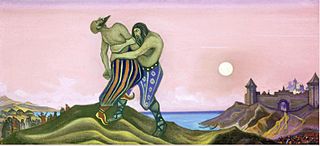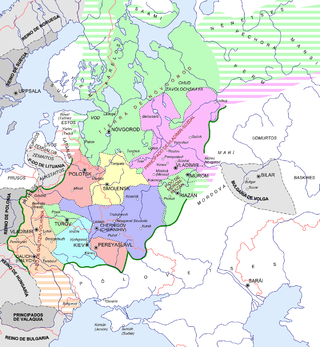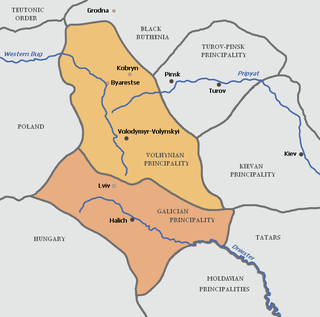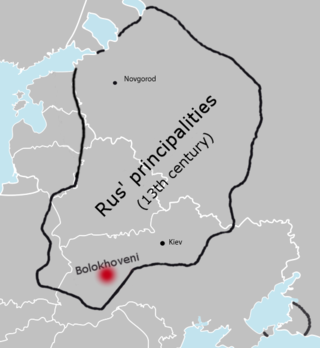
Year 1223 (MCCXXIII) was a common year starting on Sunday of the Julian calendar.

Volhynia or Volynia is a historic region in Central and Eastern Europe, between southeastern Poland, southwestern Belarus, and northwestern Ukraine. The borders of the region are not clearly defined, but in Ukraine it is roughly equivalent to Volyn and Rivne Oblasts; the territory that still carries the name is Volyn Oblast.

The Principality or, from 1253, Kingdom of Galicia–Volhynia, also known as the Kingdom of Ruthenia or Kingdom of Rus, was a medieval state in Eastern Europe which existed from 1199 to 1349. Its territory was predominantly located in modern-day Ukraine, with parts in Belarus, Poland, Moldova, and Lithuania. Along with Novgorod and Vladimir-Suzdal, it was one of the three most important powers to emerge from the collapse of Kievan Rus'.

Iziaslav Yaroslavich was Prince of Turov and Grand Prince of Kiev.

Mstislav I Vladimirovich Monomakh, also known as Mstislav the Great, was Grand Prince of Kiev from 1125 until his death in 1132. After his death, the state began to quickly disintegrate into rival principalities.

The Principality of Chernigov was one of the largest and most powerful states within Kievan Rus'. For a time the principality was the second most powerful after Kiev. The principality was formed in the 10th century and maintained some of its distinctiveness until the 16th century. The Principality of Chernigov consisted of regions of modern-day Ukraine, Belarus, and Russia.

Mstislav Vladimirovich was the earliest attested prince of Tmutarakan and Chernigov in Kievan Rus'. He was a younger son of Vladimir the Great, the grand prince of Kiev. His father appointed him to rule Tmutarakan, an important fortress by the Strait of Kerch, in or after 988.

The Principality of Galicia, also known as Principality of Halych or Principality of Halychian Rus', was a medieval East Slavic principality, and one of the main regional states within the political scope of Kievan Rus', established by members of the oldest line of Yaroslav the Wise descendants. A characteristic feature of the Galician principality was the important role of the nobility and citizens in political life, and consideration a will which was the main condition for the princely rule. Halych as the capital mentioned in around 1124 as a seat of Ivan Vasylkovych the grandson of Rostislav of Tmutarakan. According to Mykhailo Hrushevsky the realm of Halych was passed to Rostyslav upon the death of his father Vladimir Yaroslavich, but he was banished out of it later by his uncle to Tmutarakan. The realm was then passed to Yaropolk Izyaslavich who was a son of the ruling Grand Prince Iziaslav I of Kiev.

The inner Principality of Kiev was a medieval principality centered on the city of Kiev.
The Prince of Pereyaslavl was the ruler of the Principality of Pereyaslavl, a lordship based on the city of Pereyaslavl on the Trubizh River, and straddling extensive territory to the east in what are now parts of Ukraine. It was situated on the southern frontier of Kievan Rus' and bordered the steppe.

The Principality of Smolensk was a Kievan Rus' lordship from the 11th to the 16th century. Until 1127, when it passed to Rostislav Mstislavich, the principality was part of the land of Kiev. The principality gradually came under Lithuanian influence and was incorporated into the Grand Duchy of Lithuania in 1404. The principality was reorganized into the Smolensk Voivodeship in 1508. The Principality of Moscow controlled the city from 1514 to 1611, then it was recaptured by the Polish–Lithuanian Commonwealth. Tsardom of Russia recaptured the city in 1654.

The Council of Liubech was one of the best documented princely meetings in Kievan Rus' that took place in Liubech on October 19, 1097. The council ended the Chernihiv war of succession (1093–1097) between Sviatopolk II of Kiev, Vladimir II Monomakh and Oleg I of Chernigov who fought for the heritage of his father Sviatoslav II of Kiev.

Bilhorod Kyivskyi or Belgorod Kiyevsky was a legendary city-castle in Kievan Rus', on the right bank of the Irpin River. The remains of the city are in Kyiv Oblast, Ukraine.

The Rurik dynasty, also known as the Rurikid or Riurikid dynasty, as well as simply Rurikids or Riurikids, was a noble lineage allegedly founded by the Varangian prince Rurik, who, according to tradition, established himself at Novgorod in the year 862. The Rurikids were the ruling dynasty of Kievan Rus' and its principalities following its disintegration.

The Principality of Turov, later called the Principality of Turov and Pinsk, also known as Turovian Rus', was a medieval principality of Kievan Rus' from the 10th century on the territory of modern-day Belarus and northern Ukraine. The princes of Turov often served as grand princes early in 10th and 11th centuries. Its capital was Turov (Turaŭ), and other important cities included Pinsk, Mazyr, Slutsk, Lutsk, Brest, and Volodymyr.

The Principality of Volhynia was a western Kievan Rus' principality founded by the Rurikid prince Vsevolod in 987 centered in the region of Volhynia, straddling the borders of modern-day Ukraine, Belarus, and Poland. From 1069 to 1118, it belonged to Izyaslavichi who primarily ruled from Turov. After losing Turov to Monomakhovichi in 1105, the descendants of Iziaslav Yaroslavovich for a few years continued to rule in Volhynia. From 1154 to 1199, the Principality was referred to as the Principality of Volodymyr when the Principality of Lutsk (1154–1228) was separated.
The Bolokhovians, Bolokhoveni or Bolokhovens were a 13th-century ethnic group that resided in the vicinity of the principalities of Galicia, Volhynia and Kiev, in the territory known as the "Bolokhovian Land" centered at the city of Bolokhov or Bolokhovo. Their ethnic identity is uncertain; although Romanian scholars, basing on their ethnonym identify them as Romanians, archeological evidence and the Hypatian Chronicle suggest that they were a Slavic people. Their princes, or knyazes, were in constant conflict with Daniel, the prince of Galicia–Volhynia, between 1231 and 1257. After the Mongols sacked Kiev in 1240, the Bolokhovians supplied them with troops, but the Bolokhovian princes fled to Poland. The Bolokhovians disappeared after Daniel defeated them in 1257.

Bolokhov was a city mentioned in the Kievan and Galician–Volhynian chronicles, which gave the name to the Bolokhovian Land, but that has not yet been found or identified. The currently known chronicle texts, like other historical sources, do not allow to determine the location of the city of Bolokhov with acceptable, sufficient archaeological accuracy. M. Dimnik claims that this land may have been located in the southwest corner of the Principality of Kiev and that it also shared borders with Volhynia and Galicia. According to Andrey Kuza, Bolokhov was located in modern-day Liubar.

















